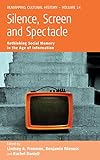Silence, Screen, and Spectacle : Rethinking Social Memory in the Age of Information / ed. by Rachel Daniell, Benjamin Nienass, Lindsey A. Freeman.
Material type: TextSeries: Remapping Cultural History ; 14Publisher: New York ; Oxford : Berghahn Books, [2014]Copyright date: ©2014Description: 1 online resource (260 p.)Content type:
TextSeries: Remapping Cultural History ; 14Publisher: New York ; Oxford : Berghahn Books, [2014]Copyright date: ©2014Description: 1 online resource (260 p.)Content type: - 9781782382805
- 9781782382812
- P96.H55 S55 2014
- online - DeGruyter
| Item type | Current library | Call number | URL | Status | Notes | Barcode | |
|---|---|---|---|---|---|---|---|
 eBook
eBook
|
Biblioteca "Angelicum" Pont. Univ. S.Tommaso d'Aquino Nuvola online | online - DeGruyter (Browse shelf(Opens below)) | Online access | Not for loan (Accesso limitato) | Accesso per gli utenti autorizzati / Access for authorized users | (dgr)9781782382812 |
Frontmatter -- Contents -- Illustrations -- Acknowledgments -- Introduction: Rethinking Social Memory in the Age of Information -- Part I Spectacular Memory: Memory and Appearance in the Age of Information -- Chapter 1 Haunted by the Spectre of Communism: Spectacle and Silence in Hungary’s House of Terror -- Chapter 2 Making Visible: Reflexive Narratives at the Manzanar U.S. National Historic Site -- Chapter 3 The Everyday as Spectacle: Archival Imagery and the Work of Reconciliation in Canada -- Part II Screening Absence: New Technology, Affect, and Memory -- Chapter 4 Viral Affiliations: Facebook, Queer Kinship, and the Memory of the Disappeared in Contemporary Argentina -- Chapter 5 Learning by Heart: Humming, Singing, Memorizing in Israeli Memorial Videos -- Chapter 6 Arcade Mode: Remembering, Revisiting, and Replaying the American Video Arcade -- Part III Silence and Memory: Erasures, Storytelling, and Kitsch -- Chapter 7 Remembering Forgetting: A Monument to Erasure at the University of North Carolina -- Chapter 8 The Power of Conflicting Memories in European Transnational Social Movements -- Chapter 9 Memories of Jews and the Holocaust in Post-Communist Eastern Europe: The Case of Poland -- Chapter 10 1989 as Collective Memory “Refolution” East-Central Europe Confronts Memorial Silence -- Conclusion: Comments on Silence, Screen, and Spectacle -- Contributors -- Index
restricted access online access with authorization star
http://purl.org/coar/access_right/c_16ec
In an age of information and new media the relationships between remembering and forgetting have changed. This volume addresses the tension between loud and often spectacular histories and those forgotten pasts we strain to hear. Employing social and cultural analysis, the essays within examine mnemonic technologies both new and old, and cover subjects as diverse as U.S. internment camps for Japanese Americans in WWII, the Canadian Indian Residential School system, Israeli memorial videos, and the desaparecidos in Argentina. Through these cases, the contributors argue for a re-interpretation of Guy Debord’s notion of the spectacle as a conceptual apparatus through which to examine the contemporary landscape of social memory, arguing that the concept of spectacle might be developed in an age seen as dissatisfied with the present, nervous about the future, and obsessed with the past. Perhaps now “spectacle” can be thought of not as a tool of distraction employed solely by hegemonic powers, but instead as a device used to answer Walter Benjamin’s plea to “explode the continuum of history” and bring our attention to now-time.
Mode of access: Internet via World Wide Web.
In English.
Description based on online resource; title from PDF title page (publisher's Web site, viewed 25. Jun 2024)


